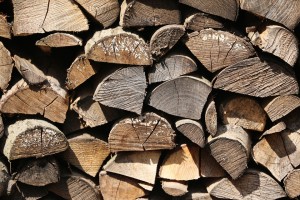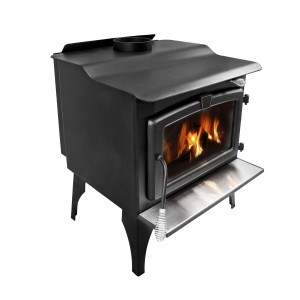A wood burning stove is only as good as the heat it can provide. With the purchase of a wood stove, the size of the stove really matters. Because this stove requires wood to produce heat, a stove with a bigger fireplace tends to produce more heat than one with a smaller fireplace. The amount of heat given out by the stove will thus be determined by the amount of wood it can burn in a particular period.
The only problem is that stoves are specified based on the nominal heat output. This means that the figures can be played with. For instance, a rating of 5KW can be given to different stoves based on the stove’s structure and other variances such as the wood used. But why would the manufacturer want to have the stove rated at 5KW or less, while they could add a log or two to provide 8KW? This is simply because in most states, stoves with 5KW or fewer ratings do not need to have an air vent in the room.
Our advice: If you are in a wood burning stove retail outlet, do not make your decision based on the BTU rating. Instead, compare the sizes of the firebox and think about the number of logs the stove can reasonably hold.
Factors To Consider When Buying Wood Stoves
Space To Be Heated
To determine which is the best wood stove size for your home, you need to understand your energy needs. To obtain these calculations, measure the length, width and height of your room. Multiply the three figures to give you the room’s volume. If the house is new and fitted with good installation, divide the volume by 25. If it has average to good insulation, divide its volume by 15. If the room has poor or no insulation, divide the volume by 10. If you aren’t sure about the insulation, divide the room’s volume by 15. The result you get from the divisions will be the room’s KW requirement. (Note: be sure to calculate the volume in meters).
Even with the calculations, some adjustments may be necessary to allow room for heat loss. The stove can never be 100% and will lose a lot of heat. The location of the stove may also determine the amount of heat enjoyed. If your goal is heating the whole house, place the stove in the central part of the house. Wood stoves are radiant heaters, meaning that areas adjacent to the stove will be warmer than those far from it. The heat produced has a tendency of darning up behind doors. This will only spill after enough heat has accumulated in the room. The heat can spread to adjacent rooms but will not easily find its way into back rooms or down narrow hallways. Consider having a small fan in the upper corner of the door headers to distribute the heat.
When calculating your home’s volume, always consider the rooms that need to be heated only. Sizing the entire home can result to overheating, especially if the area is largely closed. This means that getting a small stove to heat a small room would be the best idea. However, if this room opens up to other rooms, heat may dissipate over the larger area. This may make you feel like you made the wrong choice.
How Much Heat Loss Do You Expect?
Heat loss is an integral part of the sizing equation. In theory, a room could be designed that only needs a light bulb to be well heated. However, this doesn’t apply in the real world. Heat loss is a fact of life. Whether your home’s design is modern or more conventional, natural factors such as solar gain, wind and the climate will always affect your home’s heating.
One of the major heat loss contributors is the difference in temperatures inside and outside the room. The higher the temperature difference, the greater the heat loss will be. This can be controlled when building the house or even after the house has been constructed. Locate the house where it will take advantage of the passive solar gain is one of the solutions. Alternatively, you can use building materials that absorb and store heat.
Calculating your heat loss
 Heat loss is a figure that has always seemed to be elusive for an average homeowner. They may have realized that they are losing some heat, but qualifying it seems to be next to impossible. Heating and cooling engineers have come up with fairly accurate ways of determining the average amount of heat loss. This is done by measuring the net area of the window, wall and the roof and determining their heat transfer coefficients.
Heat loss is a figure that has always seemed to be elusive for an average homeowner. They may have realized that they are losing some heat, but qualifying it seems to be next to impossible. Heating and cooling engineers have come up with fairly accurate ways of determining the average amount of heat loss. This is done by measuring the net area of the window, wall and the roof and determining their heat transfer coefficients.
According to EPA’s study, an average home, 1600 square feet, in the cooler northern climates requires between 24,000 and 48,000 BTUs/hr during a typical winter. This is based on a single-story home made of wood, with double paned windows, 3 ½” insulation in the wall, 9” in the ceiling and 6 inches in the floor. If the house is poorly insulated, you would need to increase the figure by 20 or 30%. On the other hand, if it is super insulated; you will have to deduct a percentage.
The Type Of Fuel Used
 There are different types of wood and every type has its estimated BTU output. They also have inherent rise and fall cycles which ought to be considered. The BTU content is mainly determined by the wood species and the moisture content. Burning well-seasoned dry hardwoods minimizes wood fuel irregularities. On the other hand, softwoods and wood high in moisture content increase fuel irregularities. Whether you cut your own wood or buy from the store, you need to know what heat output to expect. This is crucial in the wooden stove selection process.
There are different types of wood and every type has its estimated BTU output. They also have inherent rise and fall cycles which ought to be considered. The BTU content is mainly determined by the wood species and the moisture content. Burning well-seasoned dry hardwoods minimizes wood fuel irregularities. On the other hand, softwoods and wood high in moisture content increase fuel irregularities. Whether you cut your own wood or buy from the store, you need to know what heat output to expect. This is crucial in the wooden stove selection process.













